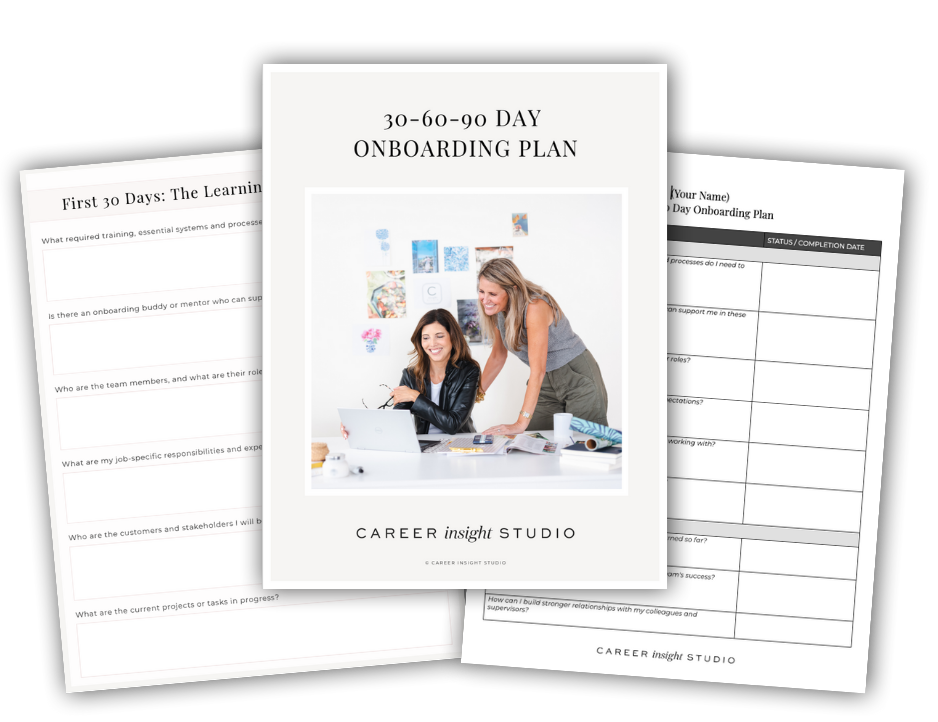Starting a new job can be daunting but having a comprehensive 30-60-90 day onboarding plan can help set you up for success.

While starting a new job or role can be exciting, it can also feel pretty overwhelming. Besides learning the company culture, new people, and processes, there is often pressure to come up to speed quickly.
Whenever I start something new, I find developing a solid onboarding or transition plan helps. Not only does this activity accelerate the learning process, but it keeps me focused on the things that matter most to the organization. And here’s the good news….it doesn’t need to be complicated!
Here’s some basic context on why having a plan is important–and the benefits.
The Importance of an Onboarding Plan
 One resource I have leveraged is a book called The First 90 Days by Michael D. Watkins–I have turned to this resource every time I’ve stepped into a new or different role.
One resource I have leveraged is a book called The First 90 Days by Michael D. Watkins–I have turned to this resource every time I’ve stepped into a new or different role.
Watkins talks about having a 30-60-90 day plan as a strategic roadmap for new employees, guiding them through their first three months on the job. It’s a check-in of sorts – for yourself! Warning…this book is not what I’d call a “light read,” and it is geared more toward people in leadership positions, but it does have some sound advice on how to manage transitions and new roles successfully. He starts the book by saying “The President gets 100 days to prove himself–you get 90.” Let’s hope Watkins will have a reason to revise this analogy, should we see a woman take on the presidential role some day 😊
It may be obvious, but here’s why having an onboarding plan matters:
1. Clear Direction: When you create specific tasks and goals, it creates clarity on where to focus your time and ensures your efforts are aligned with your manager’s expectations and the company’s objectives.
2. Rapid Adaptation: The initial period in starting a new job is a learning curve. Having a plan allows for a quicker adaptation, helping you integrate into the company culture, understand processes, and navigate your responsibilities efficiently.
3. Goal Achievement: By concentrating on key areas, you can set and achieve tangible goals within the first 90 days. This not only showcases your capabilities but also establishes your value to the team and the organization.
4. Building Relationships: Identifying your key stakeholders early on will help you build meaningful relationships with colleagues, supervisors, and internal and external stakeholders. Strong connections enhance collaboration to support and contribute to a positive work environment.
5. Continuous Improvement: As you work through your plan, you can identify opportunities for improvement. Also, by honing in on specific aspects of your role, you can actively seek feedback, make necessary adjustments, and grow both personally and professionally.
The 30-60-90 Day Framework
Here’s a brief rundown of what the onboarding plan could look like when starting a new role.
- The First 30 Days:
- Learn and Observe: Dedicate the initial days to absorbing information about the company’s culture, processes, and role. Take any necessary training that is offered as a new employee and read up on the latest news and offerings. Tip: If you join a company in a remote capacity, ask your manager what meetings you can be included in to shadow them. It’s an easy way to learn and observe without requiring them to carve out a lot of additional time on their already busy calendar.
- Build Relationships: Initiate conversations, participate in team activities, and create connections with your colleagues.
- Seek Guidance: Don’t hesitate to ask questions and seek guidance from your manager and peers. If your company doesn’t offer an “onboarding buddy,” ask your manager who you could meet with to answer questions you may have as you are coming up to speed.
- The Next 30 Days:
- Contribute Actively: Start adding value based on your understanding from the first 30 days. Show initiative and if you are working remotely, be sure you are visible – yep, your video camera should be on as much as possible when joining team calls. Otherwise, you run the risk of being “out of sight, out of mind.”
- Set Short-Term Goals: Define achievable goals aligned with team and organizational objectives to demonstrate your commitment and contribution.
- Embrace Feedback: Actively seek feedback to refine your approach and ensure you’re on the right track.
- The Final 30 Days:
- Independence and Impact: Demonstrate your ability to manage your responsibilities independently and identify areas where there may be a gap you could provide a positive impact.
- Professional Growth: Identify opportunities for professional development and set goals for your ongoing learning.
- Share Insights: If appropriate, share your observations and fresh perspectives with your manager from the first 90 days. The benefit of being new is the ability to see things from a different perspective – surface those opportunities that may add value to the team and organization.
Crafting Your Own 90-Day Plan
Ready to get started?
Now is the opportune moment to craft your custom 90-day plan, guiding your journey with clarity and simplicity. As you achieve milestones, it serves not only as a record of success but also as an opportunity for constructive feedback in 1:1 conversations, to ensure you’re headed in the right direction.
In the resource section, feel free to download a complimentary 30-60-90-day onboarding guide and two template options. These customizable templates will help you stay focused, align with peers, managers, and key stakeholders, and set yourself up for success in your new role. And if you need help with the process, feel free to book a mentor session.
Happy planning!





Absolutely fabulous plan. I have that book but I’ve learned that execution is the key. Thanks for your brilliant insights!
Thank you, Bill! I agree, execution is crucial and it’s something you are so good at! Thanks for contributing to the conversation 🙂
Love this article and valuable resources. When coaching clients, I say the high level theme is to over-communicate. This helps build trust and gets everyone on the same page (including you ; )
Absolutely. Great advice Julie! Thank you 🙂